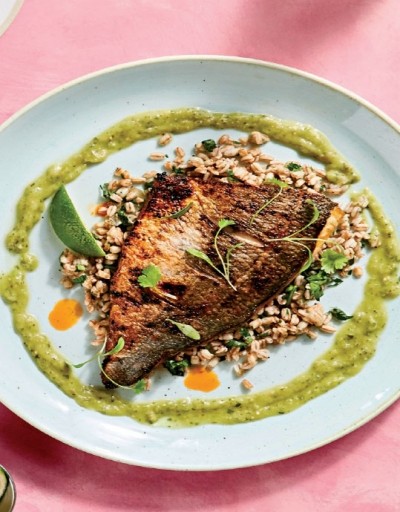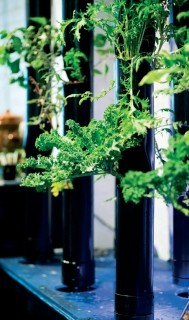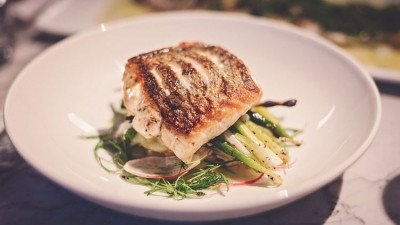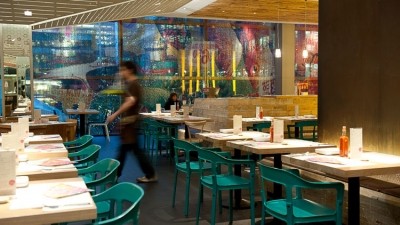Six areas to make your restaurant more sustainable

Meat
A study published by the University of Oxford on the environmental impact of agriculture last year made sobering reading for meat lovers. The research found meat and dairy provided just 18% of the world’s calories but accounted for 83% of farmland and 60% of agriculture’s greenhouse gases.
Topping the list of offenders was beef, which produces up to 105kg of greenhouse gases per 100g of meat, followed by lamb (27kg), pork (14kg) and chicken (12kg).
But there are big differences depending on how meat is produced. Beef cattle reared on deforested land results in 12 times more greenhouse gases than those grazing rich natural pasture. For restaurants looking to source meat with lower environmental impact, asking questions about animal welfare is a good start, says Andrew Stephen, CEO of the Sustainable Restaurant Association (SRA).
“If farms are avoiding soya and the routine use of antibiotics in feed, they are good indicators that it’s going to be lower impact,” he says. Better still is to reduce the amount of meat used in the kitchen. “We advise no more than 85g of red meat on a plate – that’s how much protein your body can process in a meal,” says Stephen. “If we can re-imagine dishes, we’re in a much better place of what normal looks like.”
At Café St Honoré in Edinburgh, chef-director Neil Forbes has reduced meat use by 10% to 20%, while profitability on meat dishes is up 20%. “We used to do a big piece of roasted pork belly with crackling, mash and cabbage,” he says. “Now we’re doing a smaller piece of rolled belly with chorizo and lentils, as well as kale, Cavolo Nero and roasted carrots.”
Fish
Do you know your demersal otter trawl from your longline? It’s the kind of detail you need to understand when you wade into the fast moving waters of sustainable fish. “We assumed buying British day-boat was enough, but it’s not that simple,” says Andrei Lussman, owner of five-strong Lussmanns Sustainable Fish & Grill. “It’s fraught with complication, politics, changing views and wrong perceptions.”
Lussmanns serves Marine Stewardship Council (MSC) accredited fish, paying 8-12% more for it compared to non-sustainable options, with the company sticking to cod, hake, plaice and haddock to ensure availability. “If you’re designing menus five months in advance, we have to rely on economies of scale and guaranteed supply,” he says.
Encouraging diners to order less well known sustainable fish has proved tricky. “We put MSC coley on the menu, but people think of it as poor white fish for cats,” adds Lussman. “It was a waste of time.”
Wahaca’s commitment to MSC fish means auditing all 28 of its restaurants each year, which takes around two weeks. Co-founder Thomasina Miers says prices can also be significantly higher. “We used to buy MSC prawns and scallops, however these are now either no longer available or so cost-prohibitive that we can’t include them on our menu,” she says. The company also serves farmed fish (suppliers are audited by the restaurant directly), including bream and, most recently, Chalk Stream Trout – a fish that is rising in popularity as concerns grow about animal welfare and the environmental impact of farmed salmon.
“The more we buy into sustainable alternatives to wild fish like Chalk Stream Trout the more we can allow global fish stocks to rejuvenate and replenish,” says Miers.
Farmed fish is something that Norway has developed since the 1970s, when wild salmon from 40 different Norwegian rivers were collected to breed in floating sea pens, and the country is now home to an advanced aquaculture industry. Norwegian cod and haddock is also very sustainable from closely scrutinised MSC-certified stocks. The country was the first in the world to implement a fishing quota system and a zero-waste discard ban, says Hans Frode Kielland Asmyhr, UK director at the Norwegian Seafood Council, adhering to quotas recommended by the International Council for the Exploration of the Seas.
Royal Greenland, meanwhile, says it engages in co-operation at various levels in order to ensure long-term sustainability for the fisheries in the North Atlantic and the Arctic Ocean. Among its initiatives, the company turns unwanted prawn shells into shrimp meal at its Ilulissat factory and says that for its halibut, utilisation of the fish was 94%, with only skin and bones discarded during production. In some Greenlandic villages skin and bones are used for animal feed.
Dairy
The dairy industry is under greater scrutiny as criticism from vegan campaigners on animal welfare and sustainability issues begins to bite. Producers are responding with innovative new schemes, such as the Free Range Dairy Pasture Promise logo, launched by Neil Darwent in 2014. This guarantees that milk comes from cows that have grazed outside for at least six months on farms where bull calves are not euthanised. The 60 small farms that are part of the scheme are paid a premium of 2p-2.5p per litre and are now supplying customers including English Lakes hotels and catering wholesaler Foodspeed.
“What gets lost is that grazing livestock is an entirely different proposition environmentally to intensively farmed feedlot operations,” says Darwent. “Not only do we have carbon sequestration [the long-term storage of carbon in plants and soils] with cattle at pasture, there’s also a natural carbon cycle. They put nutrients back into the soil.”
In Dumfries and Galloway, cheese producer The Ethical Dairy is pioneering a method where cows are not separated from their offspring (as happens on most dairy farms). Instead, the calf is allowed to suckle during the day. Milk volumes have fallen by a third, but the difference to the animals’ wellbeing has been marked, while feed costs have plummeted and the cows are living longer, it says.
“There are lots of huge dairies focused on increased production and low prices,” says co-owner Norma Finlay. “But the public are becoming aware of the conditions cows are kept in and the backlash is inevitable.”
Energy use
When Whatley Manor executive chef Niall Keating sat down to plan his new kitchen, energy efficiency was a high priority, both from an environmental and a financial perspective.
“We had gas flat tops, a salamander [grill] and a stock pot before the refurbishment that would burn fuel from 6am-10pm,” he explains.
“Now we have installed induction and electric hobs that only draw power when needed. We have also added a pressure-based Rational stock pot, which reduces the time it takes to make a stock by more than half. It will make a significant change to our costs.”
The all-electric Athanor stove features three plancha cook plates, an integrated water bath, individual induction hobs and a ‘quick therm’ salamander grill.
As well as being more environmentally friendly, greener kit, such as induction, is also more friendly on the wallet. According to John Whitehouse, chair of the Catering Equipment Suppliers Association, 82% of a catering appliance’s lifecycle cost is the energy used in its operation. “It is economic short-sightedness not to specify energy-saving equipment,” he says, adding that one of the key trends going forward will be ‘connectivity’ so that equipment can be monitored online. “Service providers can ensure not only that it is always working at optimum efficiency, but also that if there are any equipment issues they can be dealt with before they cause damage.”
Klaus Goeldenbot, group CEO at kitchen equipment supplier Nisbets, shares this view. Where being energy-efficient was once a nice thing to do, now it’s imperative – for both the environment and operator bottom lines – he says.
Operators can start to reduce energy costs by considering what equipment is needed and when. “For example, prime cooking equipment does not need to be switched on at the start of the day if there is no need for it until closer to service,” says Goeldenbot. “Simple measures can make significant savings over time.”
Regular maintenance is also key to ensuring the efficiency of equipment, for example, worn oven or refrigerator door seals will leak, meaning that the unit will need to work even harder to maintain the correct temperature, thus increasing energy usage. Taking time to assess energy usage and identifying the biggest expenditures can help operators pinpoint where they can save money and where they are losing it.
Goeldenbot also believes that diners actively seek out greener operations. “Consumers are becoming increasingly aware of which restaurants are sustainable and energy efficient,” he says. “Their eating-out choices are often influenced by the current news agenda, meaning they are aware of the impact restaurants have on the environment. Given a choice, many consumers would opt to eat at a sustainable restaurant that demonstrated its commitment to reducing its carbon footprint.”
Plastics
Controversy over single-use plastics has coalesced around straws and disposable cups partly because they are so visible to the public. But there are plenty of problems behind the kitchen door with mountains of packaging arriving with deliveries and miles of cling film used to wrap food.
James Fowler became so fed up with the situation that he introduced a raft of measures at his Bournemouth restaurant Terroir Tapas that has virtually eliminated packaging. Meat, fish and produce suppliers must deliver ingredients ‘loose’ (no packaging at all) in the restaurant’s reusable crates, which are cleaned in the dishwasher and returned to the delivery driver after unpacking.
“We’ve lost a few suppliers on the way, but interestingly some of them are now coming back to us saying they can actually do it,” he says.
Other features include draught wine and beer, an Evogro system for growing herbs and salads on the dining room wall (pictured right), which means no plastic punnets, and washable rather than disposable napkins. Cling film is also banned in the kitchen with plastic containers used instead.
Last year, the SRA launched a plastics toolkit for the hospitality sector to better understand disposable items, with guidance on materials to avoid, such as PVC, polystyrene and carbon black plastic. “It’s the ‘reduce, reuse, recycle’ mantra that is most relevant,” says CEO Andrew Stephen. “Is the item needed? Is disposable necessary? And how can we make sure it is recycled?”
Nisbets is also helping restaurants make informed choices about materials. The company has extended its Fiesta Green range with a series of new disposables including plates, cutlery, skewers, and containers made of a variety of compostable and biodegradable materials including, palm leaf, bamboo, birch and poplar wood, which it says are ideal for operators looking for solutions for alfresco dining, pop-ups and for takeaway and delivery.
Staffing
Ever since Sat Bains decided to close an extra day and move to a four-day week, there’s been a steady flow of restaurants following suit to improve staff retention.
But giving staff three days off, while keeping the restaurant open seven days is a trickier proposition. It’s one that Hand Picked Hotels took on last year with a trial at the kitchen of Ettington Park in Straford-upon-Avon, where staff retention was an issue.
“People weren’t happy and they weren’t staying,” explains operations director Douglas Waddell. “We were relying on agency staff, which meant a 40% premium. So we rebuilt the schedule for kitchen staff to work four days on and three days off.”
This involved reorganising the kitchen team and adding an extra member of staff, while existing employees worked longer shifts – over 10 hours rather than eight. Salaries stayed the same.
The results have been incredible, with staff turnover going from 70% to virtually nothing. “It’s been transformational,” says Waddell. “People have a better life-work balance and feel valued and engaged. There’s also been an improvement in profitability. We’re hitting our margins more regularly and the food is more consistent.” The 19-strong group now plans to roll it out to three other sites this year.
Other innovative ways of improving staff retention being used by restaurants include offering free English lessons, yoga classes and subsidised gym membership to staff at The Gallivant, while The Breakfast Club gives £500 baby vouchers to new parents and pays staff to volunteer at local charities.
This is a web version of an article that first appeared in the March issue of Restaurant magazine, the leading title for the UK's restaurant industry. For more features, comment, interviews and in-depth analysis of the restaurant sector subscribe to Restaurant magazine here.



















